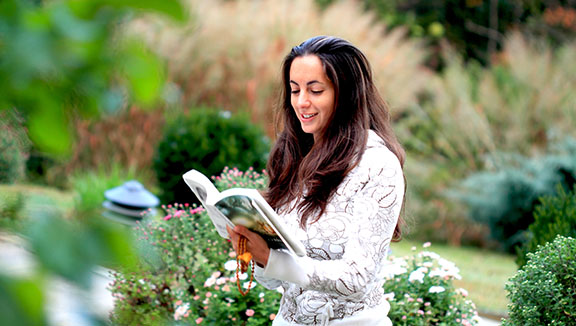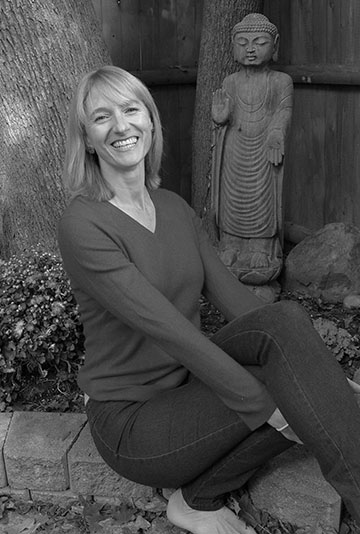 In this article, Laura Sevika Douglass shares the insights she’s gained from her own sadhana practice in the hope that readers can benefit from her experience and avoid some of the many challenges everyone encounters when trying to establish a regular practice
In this article, Laura Sevika Douglass shares the insights she’s gained from her own sadhana practice in the hope that readers can benefit from her experience and avoid some of the many challenges everyone encounters when trying to establish a regular practice
Since the time of the Vedas, 1500–1000 BCE, human beings have been asking themselves how they can gain self-knowledge and knowledge of the world, how they can follow the proper path of knowledge and the way of “truth.” Thankfully, Yoga masters like Sri Swami Satchidananda have designed systems and given us maps so we may uncover, for ourselves, the path to Self-realization. Sri Gurudev Swami Satchidananda purposefully designed Integral Yoga to be a path to truth that allows practitioners to draw on one or more, religious or yogic tradition to find their way to equanimity. While Integral Yoga has a method and practices that enable us to enact change, to easefully adopt positive habits and to find a sense of union with the world around us, how we adapt our sadhana to our particular life is often unique.
In 1995, when I began a consistent practice of Yoga, the possibilities inherent in such a flexible system of knowing was empowering but, also, daunting. Postures, breathing practices, meditation, yogic diet, ethical precepts, self-study, as well as many other contemplative practices, like chanting and offering puja, gave me so many choices. How was I, as a new Yoga practitioner, to know what to chose, or if my sadhana was leading in the right direction? In my limited experience, you can’t go wrong with sadhana! Even my mistakes have been supremely helpful in moving me toward equanimity. Here are seven insights that I gained through an incorrect approach to sadhana.
- Listen to your body. Like many individuals, my first experience of Yoga was the physical postures, or asanas. Initially I had great difficulty with the physical practices because I held the incorrect view that my body was a tool to be used and the less time I had to care for it the better. Indeed, I would be exasperated by my body’s shortcomings, injuries and needs. Asanas became the venue by which I inquired into my embodied experience—a method of listening, responding and relating to the wisdom of my lived experience. As I refined my ability to listen to my body, I found that I was able to use this feedback to guide whether I needed a vigorous or gentle practice or to focus entirely on breath-work and meditation. Listening to the wisdom of my embodied experience has been central to guiding the direction of my sadhana.
2) Relaxation is essential. In my first three years as a Yoga practitioner, I would skip Yoga Nidra to make time for work and social commitments, whenever I practiced at home. I was consistent in my sadhana, but naively wondered why Yoga felt better when I practiced in class. In 1971, Herbert Benson published one of the first studies on the benefits of relaxation, showing its positive impact on relieving stress, reducing asthmatic symptoms, lowering blood pressure and increasing immunity. Studies have recently shown relaxation causes a reduction in migraines, back pain and discomfort associated with cancer. After I began integrating Yoga Nidra into my sadhana, I began to look forward to my home practice and I noticed an increased ability to stay relaxed in stressful situations, which helped me to make better decisions and be more useful to others.
3) Learning is a collective process. Like many new to Yoga, I initially thought of my sadhana as an independent process that primarily benefited my physical and mental health. It took me ten years of practice to realize that Yoga’s primary strength is the way it creates relationships with self, family, sangha, society and divinity. The consistent practice of sadhana reveals that each one of us can only hold part of the knowledge that we seek and that collaboration and dialogue are a natural outgrowth of wanting to know and learn. By stepping into the role of co-learner and investigator of truth, we forge new relationships with communities, practices and knowledge that continually enrich our lives.
| Free Online Books on Sadhana
Krishnananda, S. (2010). Sadhana: The Spiritual Way. Rishikesh: The Divine Life Society. Available at: http://www.scribd.com/doc/7008577/Sadhana-the-Spiritual-Way-by-Swami-Krishnananda Sivananda, S. (1952). Mind: It’s Mysteries and Control. Rishikesh: The Divine Life Society. Available at: http://www.dlshq.org/download/mind.pdf Tagore, R. (1916). Sadhana:The Realization of Life. By (1916). New York: The Macmillan Company. Available at: http://www.sacred-texts.com/hin/tagore/sadh/sadh00.htm |
4) Embody your ideals. Sadhana is the radical process of choosing to do new practices. Adopting new habits seems simple, but these habits rest on long-held ideas. When a practice (such as meditation or pranayama) is added, it is unlikely to become a lasting habit unless it’s a natural expression of a shift in how we view ourselves and our daily lives. Humans are a meaning-making species, and exploring the ideas underlying what we do in our lives is a significant part of creating change. For example, if we are committed to ahimsa (non-violence), we become clearer about the necessity of enacting this idea in our daily lives: vegetarian diet, closing doors softly, speaking kindly, accepting but not causing pain. Yoga seems to work most effectively when we engage both its somatic and meaning-making practices to help close the gap between our ideals and our lived experience.
5) Simple is good. As someone with an active mind, I have a tendency to complicate things by developing detailed rational for why people engage in the activities that they do. This capacity of my mind can be useful, but simple strategies often work best. For example, when I was asked to teach a Yoga class for individuals with eating disorders, I was overwhelmed with the complexity of the disorder. I asked Swami Asokananda for suggestions on organizing the class. He said, “Love them and enjoy being with them.” I’ve been working with women with eating disorders for six years, have published multiple academic articles on the topic and am constantly asked about the work that I do by people from all over the globe. The crux of what I do is, “Love them and enjoy being with them.” It’s simple and it works!
| What is sadhana? It’s a committed prayer. It is something which you want to do, have to do and which is being done by you…Sadhana is self-enrichment. It is not something which is done to please somebody or to gain something. Sadhana is a personal process in which you bring out your best.”
Yogi Bhajan |
6) Follow your heart. I have a tendency to take false pride in my intellect and to place a high premium on intelligence, which results in the mental habit of critiquing and evaluating—with the inevitable result of frustration or anger. Through the practice of meditation, I have learned to listen and respond to my mind with compassion. Following what we love (not what we desire) is important in decisions about what practices to embrace in sadhana. There’s a felt difference between thinking about love and experiencing it. For me, sadhana is not about perfecting myself, but, rather cultivating the self-knowledge necessary to act out of and accept love.
7) Serve. The act of giving arises from joy. Prior to my consistent practice of asanas, for eight months I participated in the Integral Yoga Institute of San Francisco’s Karma Yoga program by cleaning every Wednesday. While I took Yoga classes sporadically, my primary practice was cleaning. One of the reasons I returned to clean, was that I was engaging in a familiar act, which felt peaceful in its enactment. This experience goaded me to continue studying the necessity of service. Swami Satchidananda once said, “Always try to serve others. Don’t even call it helping; call it service because you are benefiting by that.” You may find that your sadhana shifts and changes over time, that it asks you to move in new directions, resulting in service and connections to an every widening community based in love.
Engaging in sadhana for any length of time is a commitment to reclaiming one’s psychological and physiologically well being. In sadhana I learn that what needs to change is not always the external world (although sometimes it is), but the way that I interact with and conceptualize the external world. Sadhana is a commitment to learning and a deep inquiry into the way that I, as an individual, relate to self and society. Because sadhana is the way I relate to self and society, my practice and my learning will be different from yours. I believe that this joy and freedom in our individual expression is what Swami Satchidananda aimed to bring out in each of us when he outlined the eclectic path of Integral Yoga.
Sadhana is also about recognizing those aspects of self that are eternal. The Yoga master Ramana Maharishi said, “Truly there is no cause for you to be miserable and unhappy. You, yourself, impose limitations on your true nature of infinite Being and then weep that you are but a finite creature. Then you take up this or that sadhana to transcend the nonexistent limitations.”
That sounds as if sadhana is engaging us in some fool’s errand of achieving that which we already have. Of course it is! We are already whole and perfect—the trick is realizing and living out of this reality. While some individuals may have achieved this realization easily, my path has been a bit plodding, repetitive and in need of consistent sadhana. I may occasionally think my limitations are nonexistent, self-imposed mental frameworks; yet enacting my world differently doesn’t always readily follow. Sadhana has been a consistent way for me to safely and enjoyably challenge myself to explore the limitless Self. Sadhana is my way of keeping the delight and mystery of life. Sadhana is a way to play and learn; to move past any momentary hungering for name, fame, power and prestige to revel in the beauty of my short time on planet Earth. Whatever you “do” for sadhana, let it be a simple outgrowth of listening to your body, your heart and your community. Don’t be afraid to make mistakes; instead, listen and respond to the dynamics that emerge from your daily practice.
 Laura Sevika Douglass has a doctorate, with specialized study and research in Yoga psychology from Lesley University. She has been teaching Yoga in the Integral Yoga tradition since 1996 and in 1998 graduated from Dr. Vasant Lad’s Ayurvedic Institute. She is certified in prenatal, postnatal, Yoga for the Special Child, advanced Hatha Yoga and meditation. She teaches Yoga to individuals with eating disorders at an in-patient program, assists mental health professionals integrate Yogic and Ayurvedic wisdom into their healing practices and maintains a private practice in Massachusetts. For further information, please visit: www.yogapsychology.com.
Laura Sevika Douglass has a doctorate, with specialized study and research in Yoga psychology from Lesley University. She has been teaching Yoga in the Integral Yoga tradition since 1996 and in 1998 graduated from Dr. Vasant Lad’s Ayurvedic Institute. She is certified in prenatal, postnatal, Yoga for the Special Child, advanced Hatha Yoga and meditation. She teaches Yoga to individuals with eating disorders at an in-patient program, assists mental health professionals integrate Yogic and Ayurvedic wisdom into their healing practices and maintains a private practice in Massachusetts. For further information, please visit: www.yogapsychology.com.
From Integral Yoga Magazine, Fall 2011

